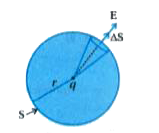InterviewSolution
Saved Bookmarks
| 1. |
Obtain Gauss's law from the flux associated with a sphere of radius rand charge 'q' at centre. |
Answer» Solution :Let US consider the total fiux through a SPHERE of radius r, which encloses a point charge q at its centre.  DIVIDE the sphere into small area elements, as shown in figure. The flux through an area element `DeltavecS` is, `Deltaphi = vecE.DeltavecS = vecE.hatr.DeltaS` where we have used Coulomb.s law for the electric field due to a single charge q. The unit vector `hatr`is along the radius vector from the centre to the area element. The area element `DeltavecS` and `hatr`have the same direction, `therefore Deltaphi =q/(4pi epsilon_(0)r^(2))DeltaS = (KQ)/r^(2) DeltaS (therefore k = 1/(4piepsilon_(0)))` The total flux through the sphere is obtained by adding up flux through all the different area elements. `therefore phi = sum_(DeltaS)(kq)/r^(2).DeltaS` `therefore phi = (kq)/r^(2) sum_(DeltaS).DeltaS = q/(4pi epsilon_(0)r^(2)) S (therefore sumDeltaS=S)` `therefore phi = q/(4pi epsilon_(0)r^(2)) xx 4pir^(2) = q/epsilon_(0)` (`therefore S = 4pir^(2)` for sphere) Gauss.s law: Electric flux through a close surface S. `phi = sum q/epsilon_(0)` `sumq` = total charge enclosed by S. The electric flux associated with any close surface is EQUAL to the ratio of net charg, enclosed by surface to `epsilon_(0)` `therefore phi = int_(S) vecE.dvecS = (sumq)/epsilon_(0)` |
|